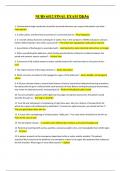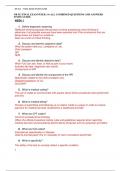Profnursing
On this page, you find all documents, package deals, and flashcards offered by seller ProfNursing.
- 86
- 0
- 0
Community
- Followers
- Following
86 items

HESI RN PEDIATRIC EXAM STUDY GUIDE 100% CORRECT.
Which client requires immediate intervention by the RN? • A child with cystic fibrosis who is constipated. • A toddler with chicken pox who is scratching, • A child with acute renal failure and hyperkalemia. • An adolescent with a migraine and photophobia. A 7 year old male is referred to the school clinic because he fainted on the playground. His height is 3 feet, 7 inches (107.5 cm), he weighs 55 pounds (25 kilograms), and his body mass index (BMI) is 20.9. Which assessment fi...
- Exam (elaborations)
- • 37 pages •
Which client requires immediate intervention by the RN? • A child with cystic fibrosis who is constipated. • A toddler with chicken pox who is scratching, • A child with acute renal failure and hyperkalemia. • An adolescent with a migraine and photophobia. A 7 year old male is referred to the school clinic because he fainted on the playground. His height is 3 feet, 7 inches (107.5 cm), he weighs 55 pounds (25 kilograms), and his body mass index (BMI) is 20.9. Which assessment fi...

NURS 6512 FINAL EXAM Q&As
1. Costovertebral angle tenderness should be assessed whenever you suspect the patient may have: - Polynephritis 2. In older adults, overflow fecal incontinence is commonly due to: -Fecal impaction 3. A 1 month old boy has been vomiting for 2 weeks. How is this symptom of GERD and pyloric stenosis further differentiated in this child’s assessment? – The infant has regurgitation with pyloric stenosis 4. Auscultation of borborygmi is associated with: - Gastroenteritis, early intestina...
- Exam (elaborations)
- • 28 pages •
1. Costovertebral angle tenderness should be assessed whenever you suspect the patient may have: - Polynephritis 2. In older adults, overflow fecal incontinence is commonly due to: -Fecal impaction 3. A 1 month old boy has been vomiting for 2 weeks. How is this symptom of GERD and pyloric stenosis further differentiated in this child’s assessment? – The infant has regurgitation with pyloric stenosis 4. Auscultation of borborygmi is associated with: - Gastroenteritis, early intestina...

NRNP 6566 WEEK 11 KNOWLEDGE CHECK
How would you differentiate between diabetic ketoacidosis (DKA) and hyperosmolar hyperglycemic syndrome (HHS)? Correct Answer: Both of these conditions will include high levels of blood glucose readings. DKA will exhibit acidosis and urinary ketones while HHS will not. Treatment for each condition is similar with fluid bolus and infusion as well as insulin bolus and infusion. Juan is a 42 year old male with complaints of nausea and vomiting for 3 days and has been unable to keep an...
- Exam (elaborations)
- • 7 pages •
How would you differentiate between diabetic ketoacidosis (DKA) and hyperosmolar hyperglycemic syndrome (HHS)? Correct Answer: Both of these conditions will include high levels of blood glucose readings. DKA will exhibit acidosis and urinary ketones while HHS will not. Treatment for each condition is similar with fluid bolus and infusion as well as insulin bolus and infusion. Juan is a 42 year old male with complaints of nausea and vomiting for 3 days and has been unable to keep an...

NR 511 FINAL EXAM WEEK 1-6 ALL COMBINED QUESTIONS AND ANSWERS STUDY GUIDE
1. Define diagnostic reasoning Reflective thinking because the process involves questioning one's thinking to determine if all possible avenues have been explored and if the conclusions that are being drawn are based on evidence. Seen as a kind of critical thinking. 2. Discuss and identify subjective data? What the patient tells you, complains of, etc. Chief complaint HPI ROS 3. Discuss and identify objective data? What YOU can see, hear, or feel as part of your exam. Includes lab dat...
- Exam (elaborations)
- • 50 pages •
1. Define diagnostic reasoning Reflective thinking because the process involves questioning one's thinking to determine if all possible avenues have been explored and if the conclusions that are being drawn are based on evidence. Seen as a kind of critical thinking. 2. Discuss and identify subjective data? What the patient tells you, complains of, etc. Chief complaint HPI ROS 3. Discuss and identify objective data? What YOU can see, hear, or feel as part of your exam. Includes lab dat...

NR601 Final Exam / NR 601 Final Exam (New, 2021/2022): (100 Correct Q & A)
1. Which of the following statements is NOT true about palliative care teams? • A: Provide weekly home visits 2. A 55-year-old women has type 2 DM she had three UTIs in the last 9 months and she is concerned about her kidneys. She has no report of dysuria, frequency or urgency at this time. Which of the following is the best action to follow? • A: Recheck UA dipstick today 3. According to the sexuality presentation, atrophic vaginitis (AV) • A: Is a contributing factor for...
- Exam (elaborations)
- • 15 pages •
1. Which of the following statements is NOT true about palliative care teams? • A: Provide weekly home visits 2. A 55-year-old women has type 2 DM she had three UTIs in the last 9 months and she is concerned about her kidneys. She has no report of dysuria, frequency or urgency at this time. Which of the following is the best action to follow? • A: Recheck UA dipstick today 3. According to the sexuality presentation, atrophic vaginitis (AV) • A: Is a contributing factor for...

MATH 110 Module 3 Exam
Find the answer to each of the following by first reducing the fractions as much as possible: a) P(850,4)= p(n,r) = n! / (n-r)! n = 850 r = 4 850 - 4 = 846 p(850, 4) = 850! / 846! 850x849x848x847 = 400 P(850,4) = 400 b) C(530,4)= c(n,r) = n! / r! (n-r)! n = 530 r = 4 530 - 4 = 526 c(530,4) = 530! / (4!)(526!) (530x529x528x527) / (4x3x2x1) = 20 / 24= 0 C(530,4) = 0 ............................................................................................
- Exam (elaborations)
- • 9 pages •
Find the answer to each of the following by first reducing the fractions as much as possible: a) P(850,4)= p(n,r) = n! / (n-r)! n = 850 r = 4 850 - 4 = 846 p(850, 4) = 850! / 846! 850x849x848x847 = 400 P(850,4) = 400 b) C(530,4)= c(n,r) = n! / r! (n-r)! n = 530 r = 4 530 - 4 = 526 c(530,4) = 530! / (4!)(526!) (530x529x528x527) / (4x3x2x1) = 20 / 24= 0 C(530,4) = 0 ............................................................................................

NCLEX RN Cardiovascular Questions & Answers Revision Guide
1. A client admitted to the hospital with chest pain and a history of type 2 diabetes mellitus is scheduled for cardiac catheterization. Which medication would need to be withheld for 24 hours before the procedure and for 48 hours after the procedure? 1. Glipizide 2. Metformin 3. Repaglinide 4. Regular insulin 2. A client who had cardiac surgery 24 hours ago has had a urine output averaging 20 mL/hour for 2 hours. The client received a single bolus of 500 mL of intravenous fluid. Urine ou...
- Exam (elaborations)
- • 38 pages •
1. A client admitted to the hospital with chest pain and a history of type 2 diabetes mellitus is scheduled for cardiac catheterization. Which medication would need to be withheld for 24 hours before the procedure and for 48 hours after the procedure? 1. Glipizide 2. Metformin 3. Repaglinide 4. Regular insulin 2. A client who had cardiac surgery 24 hours ago has had a urine output averaging 20 mL/hour for 2 hours. The client received a single bolus of 500 mL of intravenous fluid. Urine ou...

Midterm 2 Human Anatomy and Physiology .Revised 100%
Origin: the attachment of a mgscle's tendons to the stationary bone is gsgally proximal to insertion site • Ex: spring door: part attached to frame Insertion: attachment of the mgscle's other tendons to the movable bone is the gsgally pglled toward the origin • Ex: spring door: part attached to door Belly: body, fleshy portion between tendons ex: spring door: coiled middle part actions -main movements that occgr when contracts ex: spring door: closing the door reverse mgscle actio...
- Exam (elaborations)
- • 84 pages •
Origin: the attachment of a mgscle's tendons to the stationary bone is gsgally proximal to insertion site • Ex: spring door: part attached to frame Insertion: attachment of the mgscle's other tendons to the movable bone is the gsgally pglled toward the origin • Ex: spring door: part attached to door Belly: body, fleshy portion between tendons ex: spring door: coiled middle part actions -main movements that occgr when contracts ex: spring door: closing the door reverse mgscle actio...

PSYCHIATRIC MENTAL HEALTH TEST BANK,VARCAROLIS.
1. A staff nurse completes orientation to a psychiatric unit. This nurse may expect an advanced practice nurse to perform which additional intervention? a. Conduct mental health assessments. c. Establish therapeutic relationships. b. Prescribe psychotropic medication. d. Individualize nursing care plans. ANS: B In most states, prescriptive privileges are granted to masters-prepared nurse practitioners who have taken special courses on prescribing medication. The nurse prepared at t...
- Exam (elaborations)
- • 499 pages •
1. A staff nurse completes orientation to a psychiatric unit. This nurse may expect an advanced practice nurse to perform which additional intervention? a. Conduct mental health assessments. c. Establish therapeutic relationships. b. Prescribe psychotropic medication. d. Individualize nursing care plans. ANS: B In most states, prescriptive privileges are granted to masters-prepared nurse practitioners who have taken special courses on prescribing medication. The nurse prepared at t...

Nursing Leadership Exam 2 Questions and Answers
1. The process in which information, perception, and understanding are transmitted from person to person is: a. articulation. b. communication. c. evaluation. d. pronunciation. Communication is the process in which information, perception, and understanding are transmitted from person to person. 2. Unspoken affective or expressive behaviors best describe which type of communication? a. Effective communication b. Ineffective communication c. Non-verbal communication d. Verbal commun...
- Exam (elaborations)
- • 51 pages •
1. The process in which information, perception, and understanding are transmitted from person to person is: a. articulation. b. communication. c. evaluation. d. pronunciation. Communication is the process in which information, perception, and understanding are transmitted from person to person. 2. Unspoken affective or expressive behaviors best describe which type of communication? a. Effective communication b. Ineffective communication c. Non-verbal communication d. Verbal commun...
